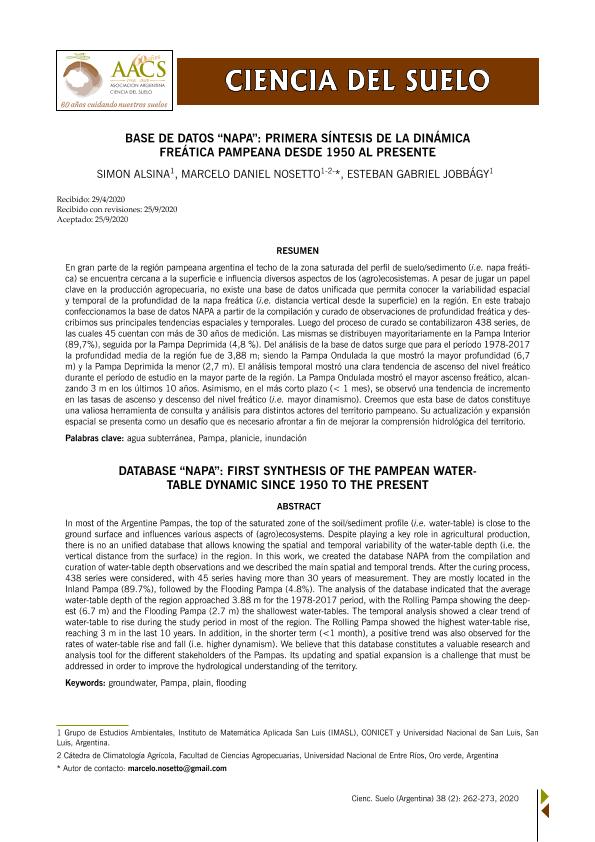Artículo
En gran parte de la región pampeana argentina el techo de la zona saturada del perfil de suelo/sedimento (i.e. napa freática) se encuentra cercana a la superficie e influencia diversos aspectos de los (agro)ecosistemas. A pesar de jugar un papel clave en la producción agropecuaria, no existe una base de datos unificada que permita conocer la variabilidad espacial y temporal de la profundidad de la napa freática (i.e. distancia vertical desde la superficie) en la región. En este trabajo confeccionamos la base de datos NAPA a partir de la compilación y curado de observaciones de profundidad freática y describimos sus principales tendencias espaciales y temporales. Luego del proceso de curado se contabilizaron 438 series, de las cuales 45 cuentan con más de 30 años de medición. Las mismas se distribuyen mayoritariamente en la Pampa Interior (89,7%), seguida por la Pampa Deprimida (4,8 %). Del análisis de la base de datos surge que para el período 1978-2017 la profundidad media de la región fue de 3,88 m; siendo la Pampa Ondulada la que mostró la mayor profundidad (6,7 m) y la Pampa Deprimida la menor (2,7 m). El análisis temporal mostró una clara tendencia de ascenso del nivel freático durante el período de estudio en la mayor parte de la región. La Pampa Ondulada mostró el mayor ascenso freático, alcanzando 3 m en los últimos 10 años. Asimismo, en el más corto plazo (< 1 mes), se observó una tendencia de incremento en las tasas de ascenso y descenso del nivel freático (i.e. mayor dinamismo). Creemos que esta base de datos constituye una valiosa herramienta de consulta y análisis para distintos actores del territorio pampeano. Su actualización y expansión espacial se presenta como un desafío que es necesario afrontar a fin de mejorar la comprensión hidrológica del territorio. In most of the Argentine Pampas, the top of the saturated zone of the soil/sediment profile (i.e. water-table) is close to the ground surface and influences various aspects of (agro)ecosystems. Despite playing a key role in agricultural production, there is no an unified database that allows knowing the spatial and temporal variability of the water-table depth (i.e. the vertical distance from the surface) in the region. In this work, we created the database NAPA from the compilation and curation of water-table depth observations and we described the main spatial and temporal trends. After the curing process, 438 series were considered, with 45 series having more than 30 years of measurement. They are mostly located in the Inland Pampa (89.7%), followed by the Flooding Pampa (4.8%). The analysis of the database indicated that the average water-table depth of the region approached 3.88 m for the 1978-2017 period, with the Rolling Pampa showing the deepest (6.7 m) and the Flooding Pampa (2.7 m) the shallowest water-tables. The temporal analysis showed a clear trend of water-table to rise during the study period in most of the region. The Rolling Pampa showed the highest water-table rise, reaching 3 m in the last 10 years. In addition, in the shorter term (<1 month), a positive trend was also observed for the rates of water-table rise and fall (i.e. higher dynamism). We believe that this database constitutes a valuable research and analysis tool for the different stakeholders of the Pampas. Its updating and spatial expansion is a challenge that must be addressed in order to improve the hydrological understanding of the territory.
Base de datos "NAPA": Primera síntesis de la dinámica freática pampeana desde 1950 al presente
Título:
Database “NAPA”: First synthesis of the pampean watertable dynamic since 1950 to the present
Fecha de publicación:
12/2020
Editorial:
Asociación Argentina de la Ciencia del Suelo
Revista:
Ciencia del Suelo
ISSN:
0326-3169
Idioma:
Español
Tipo de recurso:
Artículo publicado
Clasificación temática:
Resumen
Palabras clave:
Agua subterránea
,
Pampa
,
Planicie
,
Inundación
Archivos asociados
Licencia
Identificadores
Colecciones
Articulos(IMASL)
Articulos de INST. DE MATEMATICA APLICADA DE SAN LUIS
Articulos de INST. DE MATEMATICA APLICADA DE SAN LUIS
Citación
Alsina Torres, Simón Ezequiel; Nosetto, Marcelo Daniel; Jobbagy Gampel, Esteban Gabriel; Base de datos "NAPA": Primera síntesis de la dinámica freática pampeana desde 1950 al presente; Asociación Argentina de la Ciencia del Suelo; Ciencia del Suelo; 38; 2; 12-2020; 262-273
Compartir




